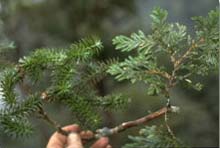Botanists Discover New Conifer Species in Vietnam

Single branch of <i>Xanthocyparis vietnamensis</i> with two foliage types. Immature foliage on the left and mature foliage on the right. <br> <br>Image courtesy of Daniel Harder, Arboretum at UCSC. <br>
An unusual conifer found in a remote area of northern Vietnam has been identified as a genus and species previously unknown to science. The limestone ridges where the tree grows are among the most botanically rich areas in Vietnam, said Daniel Harder, currently director of the University of California at Santa Cruz (UCSC) Arboretum and a co-discoverer of the new species. The discovery is published in the current issue of the journal Novon.
“Biologists don’t need to contemplate finding life on another planet to imagine making extraordinary discoveries; the fact is, most of the species living on our own planet are still unknown,” says Norman Platnick, program director in the National Science Foundation’s (NSF) division of environmental biology, which funded the research. “That kind of basic, new knowledge about life, its interrelationships, and how it is distributed across the globe, often has enormous practical implications, guiding the search for new medicines, new pesticides, and even new ways to control alien, invasive species.”
Harder spent several years in Vietnam, working to establish an on-going survey of Vietnamese plants organized by the Missouri Botanical Garden, which received the NSF funding that helped enable this research. During that time, he and his collaborators discovered more than 100 new species of plants. But the conifer now known as the golden Vietnamese cypress is by far the most remarkable of those discoveries, he said.
“For us to find a previously undescribed large tree like this indicates that there is probably a lot more to be discovered there,” Harder said. “It’s comparable to the recent discoveries of previously unknown large mammals in Southeast Asia, like the giant muntjac and the saola, a type of ox.”
Other scientists involved in the conifer discovery included Vietnamese botanists Nguyen Tien Hiep and Phan Ke Loc, Russian botanist Leonid Averyanov, and United Kingdom botanist Philip Cribb from the Royal Botanic Gardens, Kew. They found the trees clinging to steep limestone ridges in a mountainous area known as Bat Dai Son near the Chinese border.
The recently discovered tree is a new genus within the cypress family (Cupressaceae); botanists have named it Xanthocyparis vietnamensis, the golden Vietnamese cypress. Its closest relative is the yellow spruce of the U.S. Pacific Northwest, also known as the Nootka cypress. Previously classified as Chamaecyparis nootkatensis, the yellow spruce is now classified as the second species in the new genus Xanthocyparis.
The new species is distinctive in that it bears two different types of foliage (needles and scale leaves) on mature trees. It produces fine, yellowish-brown, hard, fragrant timber that is highly prized by local citizens. Logging has reduced the number of larger trees, but some very large and stately specimens still grow on the steep, rocky slopes of isolated mountain peaks, Harder said. The mountaintop ridges in Bat Dai Son hold remnants of a forest that was once much more widespread, he added.
“This tree was already rare and endangered when it was discovered, which lends urgency to putting in place some protections,” Harder said. “These limestone mountains might actually harbor other valuable species.”
In addition to the cypress, the collaborative team of botanists exploring the area has found about two dozen new orchid species, a variety of interesting new shrubs, and numerous herbs and bulbs, including a half-dozen new species in the Jack-in-the-pulpit family (Araceae).
Media Contact
All latest news from the category: Life Sciences and Chemistry
Articles and reports from the Life Sciences and chemistry area deal with applied and basic research into modern biology, chemistry and human medicine.
Valuable information can be found on a range of life sciences fields including bacteriology, biochemistry, bionics, bioinformatics, biophysics, biotechnology, genetics, geobotany, human biology, marine biology, microbiology, molecular biology, cellular biology, zoology, bioinorganic chemistry, microchemistry and environmental chemistry.
Newest articles

First-of-its-kind study uses remote sensing to monitor plastic debris in rivers and lakes
Remote sensing creates a cost-effective solution to monitoring plastic pollution. A first-of-its-kind study from researchers at the University of Minnesota Twin Cities shows how remote sensing can help monitor and…

Laser-based artificial neuron mimics nerve cell functions at lightning speed
With a processing speed a billion times faster than nature, chip-based laser neuron could help advance AI tasks such as pattern recognition and sequence prediction. Researchers have developed a laser-based…

Optimising the processing of plastic waste
Just one look in the yellow bin reveals a colourful jumble of different types of plastic. However, the purer and more uniform plastic waste is, the easier it is to…



